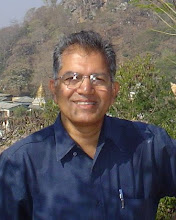Day Two of the McShane Workshop got off to a start at 0930 this morning, with a few particpants missing and a few new ones added - chiefly a couple of professors from the Department of Economics of KTHM College, and a parishioner with a background in business studies and management and his friend.
Phil began by talking about the new culture of the future. Just as we know when a person is driving badly, and we want to tell him that he should change gears, so in the future we will know when the economy is being driven badly, and there will be a widespread agreement about this, together with knowledge about what must be done.
The topics of the day were the Rhythms of Innovation, and Promises, Notes and Credit. The famous diagram which Phil began introducing yesterday moved to completion, with basic and surplus circuits, demand functions and supply functions on both levels, and the redistributive function in the middle.
Taking his example from the little barber shops that he had noticed along the Nashik streets, Phil introduced the idea of pure surplus income. An American comes in for a haircut. The usual cost of the haircut is Rs 25; but the American pays $ 5. The excess over Rs 25 is pure surplus income for the barber. Why pure? Because it is not needed for anything: for basic expenditures, or for surplus expenditures. The barber can do what he wants with it. He can donate it to a temple, or to a charitable organization, or use it for his family. In later years Lonergan called this pure surplus income also by the name social dividend, since it can be used for the benefit of humanity. If there is any money left after all the basic and surplus expenditures are met, it is pure surplus income. Pure surplus income is not necessary as long as the economy is stable.
What about the notion of profit, someone asked. Phil had been avoiding the word all through. He pointed out that profit tends to include both the surplus demand function (D'') and pure surplus income. That makes it a vague term. He also said that in traditional economics there was no criterion for determining pure surplus income and robbery (making profits by underpaying workers, or by over-pricing the goods).
Phil went on to introduce Innovation with the help of his famous Irish island and the invention of the horse-drawn plough: the banker giving credit to the inventor; the time taken for production of ploughs and the effects on the economy; the rise in wages on the surplus circuit; the problem created if these wages are immediately pumped into the basic circuit; the possibility of redistribution in terms of savings and re-investment; the eventual slowing down of the surplus surge; the need to allow then a basic surge; and so on.
The significance of the distinction between basic and surplus circuits became slowly clear, especially in comparison with diagrams from standard textbooks of economics which simply tend to lump together basic as well as surplus businesses.
Towards the end of the day, along with questions about innovations and technology displacing workers, Phil remarked that for Lonergan, the goal of the economy was, strangely, unemployment. This might be a difficult idea to digest, because we are surrounded by a mythology of work. But human beings really need to aim at a life in which there is place for leisure and contemplation. With adequate technology - including biomimicry and nanotechnology - we should be able to bring forth a sufficiency of consumer goods so as to permit leisure for all. The economy might thus slope up into a preparation for eternity!
But perhaps the most interesting part of the day was the awakening Whats: some students and SDB novices raising interesting and intelligent questions on the floor, little groups of questioners in between sessions, Dr Agnelo Menezes thinking of getting St Xavier's Mumbai to invite Phil for another Workshop. Something seems to be stirring. Seeds of hope!
Subscribe to:
Post Comments (Atom)


No comments:
Post a Comment